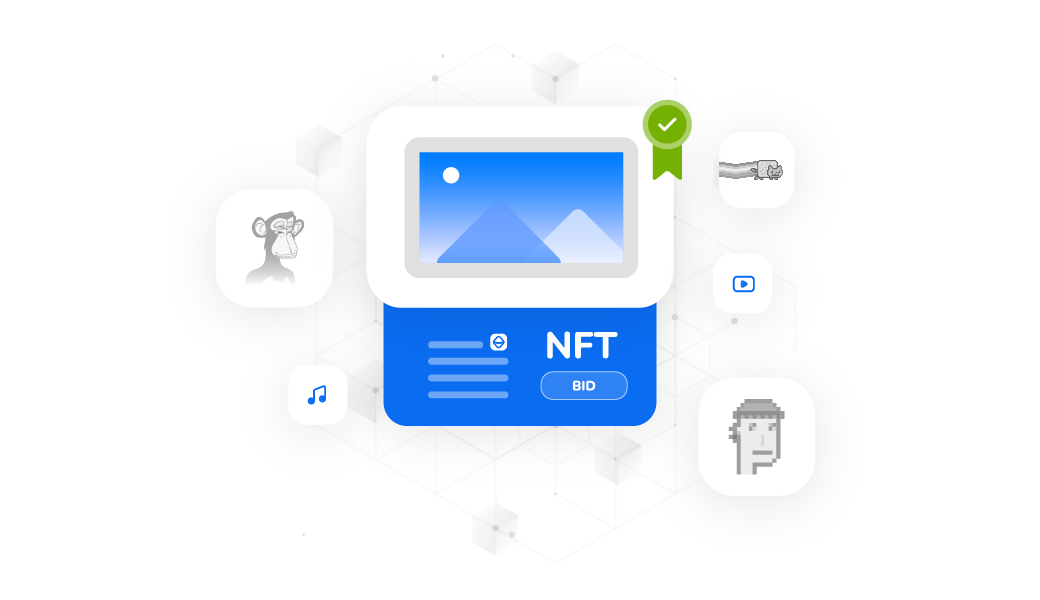How are NFTs created?
Creating an NFT looks very much like uploading a document to the web. There are some specifics however, as you will see shortly. Creating an NFT is called minting.
You can mint NFTs on Ethereum via OpenSea, on Solana via solsea or on the XRPL via the Sologenic DEX and many more. A bit of research will reveal more options and you can weigh your options by the audience you wish to reach, the ease of use or cost.
We’ll use OpenSea and Ethereum in this example and list some alternatives below. OpenSea is arguably the most widely used and most reputable NFT marketplace right now.
To mint an NFT you will need a wallet with a sufficient ETH balance to cover the cost of some transactions. You will need to connect to the marketplace with your wallet using Metamask or a similar service/plugin.
From there the creation of an NFT closely resembles uploading a file to the web. You need to upload your future NFT, add some data to describe and index it on the platform and mint.
NFTs are usually minted as parts of a collection. The most famous, the Bored Ape Yacht Club, for example, is a collection of 10,000 unique apes.
Most other platforms will work the same way. Obviously, you will need a wallet with some funds on the network where you want to mint an NFT.
How are NFTs traded?
First, the creator must offer their NFTs on the market. This can be done either at a fixed price or the item can be put up for auction for a certain period of time. At the point of sale, the platform will (in most cases) take a service fee. For each next sale, the creator can select a creator earning percentage. OpenSea’s top creator earning percentage is 12.5%.
Next, the owner can put their NFT up for sale in much the same way. Either at a fixed price or put the NFT up for auction.
You can explore some NFT marketplaces by following these links:
“Why would you buy an NFT if you can simply download it?”
This is a common criticism of NFTs that lacks a deeper understanding of the implications NFTs hold for many industries.
In short, yes, you can download a Bored Ape and use it as your Twitter avatar. Nobody can stop you from doing that but the implications of NFTs only begin here.
You can digitally copy whatever the NFT is representing but you can’t assume ownership that way or assume copyright and reproduction rights or any other perks associated with that NFT.
Let’s return to the Bored Ape from above. If there was an event that could only be attended by Bored Ape owners, you would have a hard time gaining entry with your digital copy of the NFT’s art. There might be an airdrop for holders of specific NFTs where owning a digital copy would not make one eligible.
A counter example to the question asked in the title of this section would be this. If you photographed a famous art piece you would not become its owner and you would not be able to claim any rights on it. From an example from our previous blog, copying an NFT of a contract or rights to a property would also not give you any rights derived from the actual NFT.
NFTs enable a form of artificial scarcity for digital art more in line with real-world art. It also allows more robust ownership over said art and makes transfer of ownership more convenient and transparent. The same benefits also apply to most potential use cases in the future.
The ownership case could come into play even in the real world. Your ownership of a real world item could be tied to an NFT with an immutable record on the blockchain. In that case, you would easily prove that you are the actual owner of an item. Secondary markets could require authentication before resale is allowed. This way, reselling stolen items would be much easier to detect and probably way less profitable.
What to do with NFTs?
Even though we have been able to create NFTs for quite some time, we are still at the early stages of the technology. Today’s NFTs have some use in online games, where they may represent certain in-game items or bonuses. Then there are art collections like the Bored Ape Yacht Club, Crypto Punks and others. These collections feature no special bonuses other than being able to say “I own a punk/ape”.
You can read more about the now and the future of NFTs in our previous blog.

In the future, we expect the infrastructure that supports NFTs to catch up and enable more use cases for this emerging technology. We could see ownership of such real-world items like real estate, diplomas or concert tickets represented on the blockchain.
NFTs and Security
NFT security is very similar to how security is handled with cryptocurrencies on the blockchain. They utilize the same cryptographic proofs and reside on the same underlying technology after all.
In short, securing your NFTs is practically the same as securing your crypto assets. The best way is to keep your assets and NFTs in a decentralized, non-custodial wallet and store your keys securely. Make sure to back up your seed phrases and store them offline or memorize them.
We have seen instances where NFTs have come under fire. The attack vectors are identical to those of cryptocurrency hacks. Most often the victims of these attacks were compromised via a password leak or phishing.
To secure your NFTs you can follow the steps we outlined in one of our previous blogs. The steps outlined here cover how to secure your most sensitive accounts, crypto and can also be applied to any NFT services you are using.

“NFTs only exist on Ethereum”
NFTs were first introduced to the wider audience on Ethereum when the Crypto Kitties craze hit us in 2017, although CryptoPunks were the first NFT based crypto project.
Today you can mint and trade NFTs on Ethereum by using a marketplace like OpenSea. The cost of issuing an NFT on Ethereum has skyrocketed since the inception of DeFi and other more complex use cases on Ethereum so we now have a few cheaper alternatives.
For Ethereum diehards, there is Polygon, a Layer 2 solution for Ethereum that makes costs of Ethereum tokens and transactions negligible or eliminates them altogether (similar, in principle, to Bitcoins Lightning network). You can also mint NFTs on Polygon for free.
If you’re not afraid to venture away from Ethereum there is also Solana and the XRPL. Solana provides functionalities similar to Ethereum at a fraction of the cost including DeFi and minting of NFTs.
On the XRPL, you can mint NFTs right now but the full XRPL support for NFTs is still under construction. The current standard is called XLS-14 and you are able to mint these kinds of (indivisible) NFTs via the Sologenic DEX app. This process extends on the existing functionality of issuance and should only be considered a proof of concept. The upcoming XLS-20 standard aims to support NFTs natively “along with operations to enumerate, purchase, sell and hold such tokens”.
As we can see NFTs are far from limited to only being available on the Ethereum network. Creators should have the opportunity to weigh the advantages and disadvantages of different solutions which is very much in line with the concept of the Internet of Value and supports a multichain future that is most likely to unfold.
In conclusion
We have outlined some of the basics about NFTs in our 2 part series of blogs. The history and intricacies of NFTs obviously run deeper and wider. You can read part 1 of our blog here or dip your feet a bit deeper with OpenSea’s “NFT Bible”:




